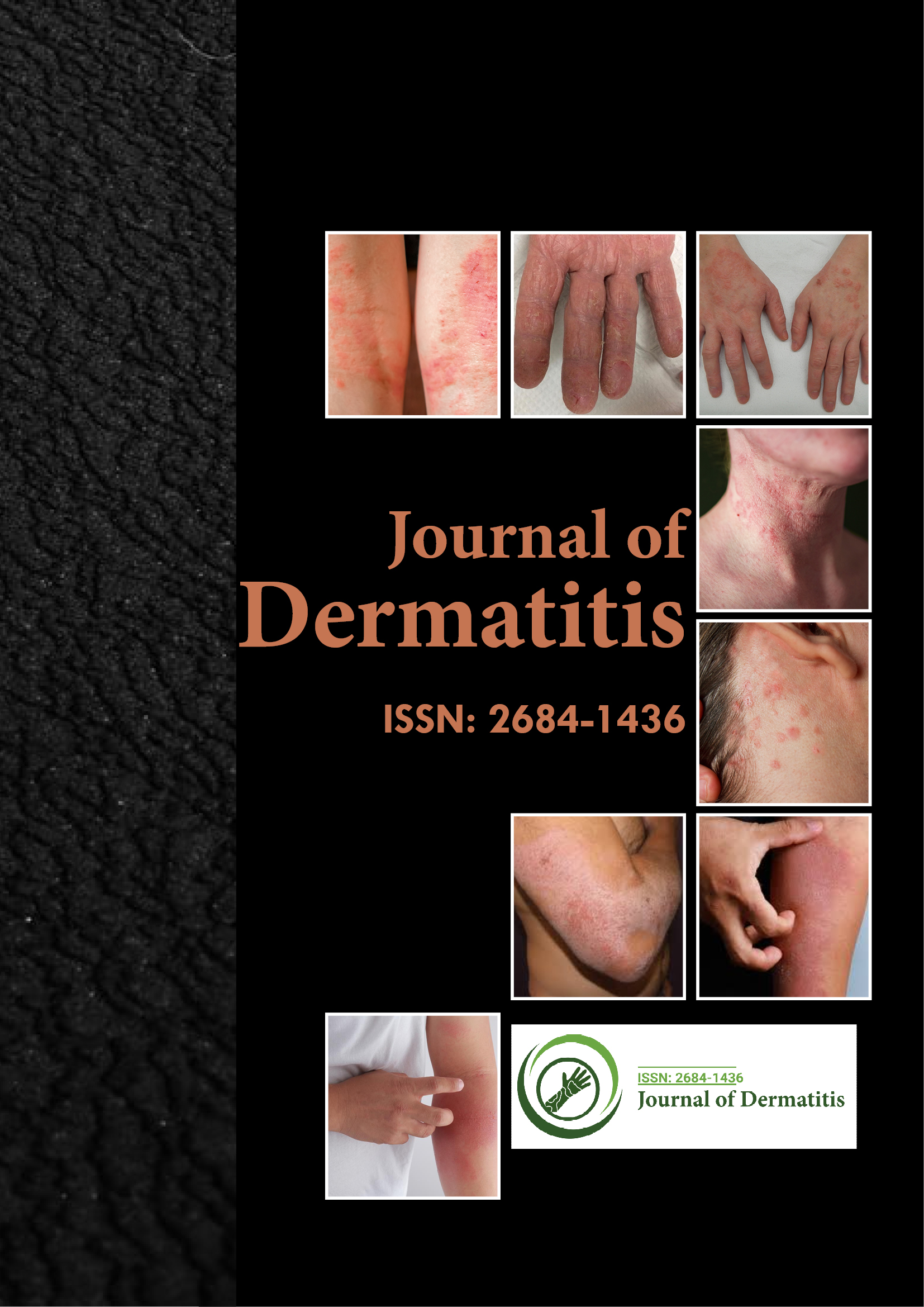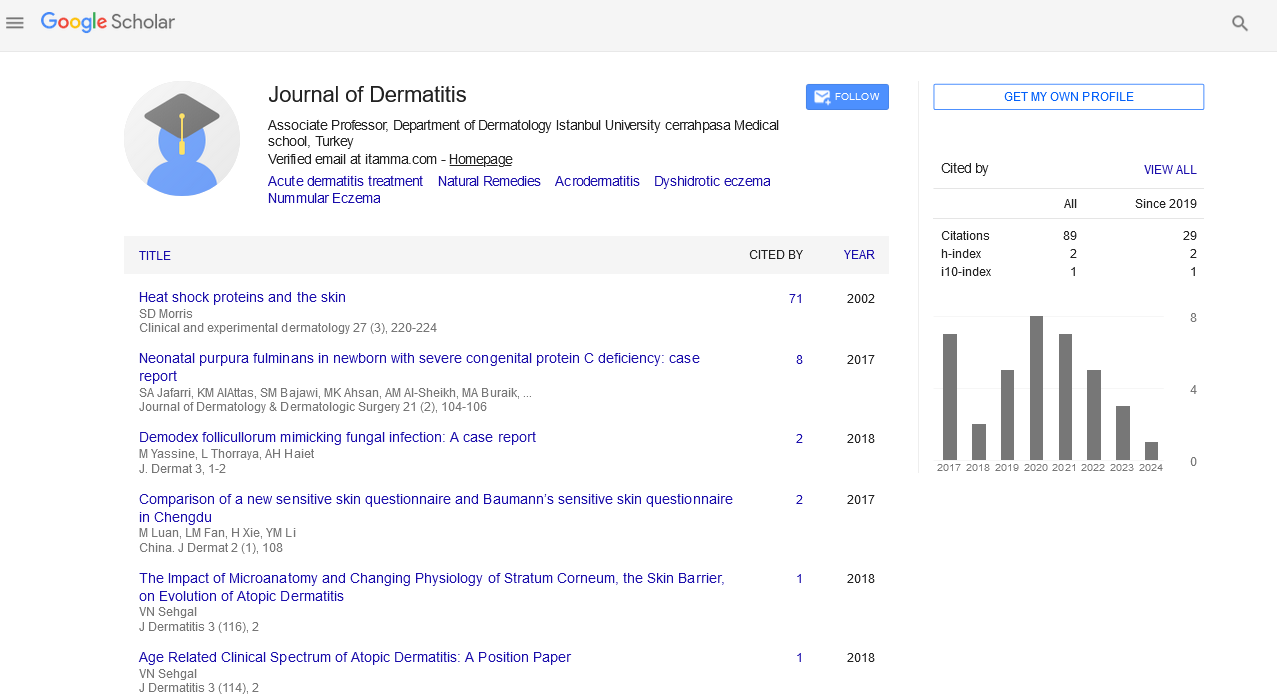Indexed In
- RefSeek
- Hamdard University
- EBSCO A-Z
- Euro Pub
- Google Scholar
Useful Links
Share This Page
Journal Flyer

Open Access Journals
- Agri and Aquaculture
- Biochemistry
- Bioinformatics & Systems Biology
- Business & Management
- Chemistry
- Clinical Sciences
- Engineering
- Food & Nutrition
- General Science
- Genetics & Molecular Biology
- Immunology & Microbiology
- Medical Sciences
- Neuroscience & Psychology
- Nursing & Health Care
- Pharmaceutical Sciences
Opinion Article - (2024) Volume 9, Issue 2
Immune Complexity in Atopic Dermatitis Complicated by Eczema Herpeticum
Carlos Mendoza*Received: 29-May-2024, Manuscript No. JOD-24-27944; Editor assigned: 31-May-2024, Pre QC No. JOD-24-27944 (PQ); Reviewed: 14-Jun-2024, QC No. JOD-24-27944; Revised: 21-Jun-2024, Manuscript No. JOD-24-27944 (R); Published: 28-Jun-2024, DOI: 10.35248/2684-1436.24.9.241
Description
Atopic Dermatitis (AD) is a chronic inflammatory skin condition characterized by intense itching, periodic exacerbations and a compromised skin barrier. The clinical heterogeneity of AD is widely recognized, with multiple immune responses and molecular endotypes contributing to its presentation. Among the most severe complications of AD is Eczema Herpeticum (EH), a viral infection caused by Herpes Simplex Virus (HSV), which presents significant clinical challenges due to its recurrent nature. Recent studies have highlighted the complexity of the immune and inflammatory environment in AD complicated by EH, pointing to the existence of multiple, concurrent epidermal inflammatory endotypes. This evolving understanding calls for a re-evaluation of current therapeutic approaches and an emphasis on precision medicine to manage such cases effectively.
AD, in its classical form, is predominantly associated with Type 2 (T2) immune responses mediated by Interleukin-4 (IL-4), IL-13 and other T2 cytokines. However, there is increasing evidence of additional inflammatory pathways, such as Type 1 (T1) and Type 17 (T17) responses, being activated in specific subsets of AD patients. This polyendotypic inflammatory environment becomes particularly pronounced in cases complicated by EH, where the co-activation of multiple immune pathways not only intensifies disease severity but also impairs effective viral clearance. Understanding the complexity of these concurrent endotypes is essential for addressing the pathophysiological basis of this complication.
One of the most important features of EH-complicated AD is the immune dysregulation that compromises the host's ability to mount an effective antiviral response. Impaired production of Interferons (IFNs), particularly IFN-γ and type I IFNs, has been observed in these patients, leaving the epidermis vulnerable to HSV replication. Simultaneously, the heightened T2 inflammation inhibits fundamental components of the innate antiviral response, creating an environment conducive to recurrent viral infections.
The concept of concurrent inflammatory endotypes in AD complicated by EH is supported by molecular profiling studies that reveal overlapping signatures of T2, T1 and T17 inflammation in lesional skin. For instance, elevated levels of IL-4 and IL-13 coexist with markers of T1 and T17 activation, such as IFN-γ and IL-17, in affected individuals. This coexpression of inflammatory pathways underscores the nonuniform nature of the immune response in EH-complicated AD, where no single pathway dominates but rather interacts in a dynamic and often deleterious manner.
From a clinical perspective, the recognition of multiple, concurrent epidermal inflammatory endotypes in EHcomplicated AD presents both opportunities and challenges. Alternatively, this insight creates the path to targeted therapies that address specific immune axes. Biologic factors targeting T2 cytokines, such as dupilumab, have shown potential in reducing the frequency and severity of EH episodes in AD patients. However, their efficacy may be limited in cases where T1 or T17 responses play a prominent role, highlighting the need for combination or sequential therapies.
On the other hand, the complexity of inflammatory endotypes raises concerns about over-suppressing immune responses, particularly in the context of active HSV infection. Broadspectrum immunosuppressants, while effective in controlling inflammation, may further impair antiviral defenses, leading to prolonged or more severe EH episodes. This sensitive balance between controlling inflammation and preserving antiviral immunity highlights the importance of personalized treatment strategies based on individual endotype profiles.
In conclusion, the characterization of multiple, concurrent epidermal inflammatory endotypes in AD complicated by EH represents a significant advancement in our understanding of this complex condition. This change in perspective highlights the heterogeneity of immune responses in AD and highlights the need for precision medicine approaches that address the unique inflammatory and immune profiles of individual patients. While current therapies have made significant progress in managing EH, the future of treatment lies in integrating biologics, barrier repair agents and microbiome-targeted interventions into a cohesive, patient-centered strategy. By adopting this comprehensive approach, we can move closer to achieving optimal outcomes for patients facing the dual burden of AD and recurrent EH.
Citation: Mendoza C (2024). Immune Complexity in Atopic Dermatitis Complicated by Eczema Herpeticum. J Dermatitis. 9:241.
Copyright: © 2024 Mendoza C. This is an open access article distributed under the terms of the Creative Commons Attribution License, which permits unrestricted use, distribution, and reproduction in any medium, provided the original author and source are credited.

